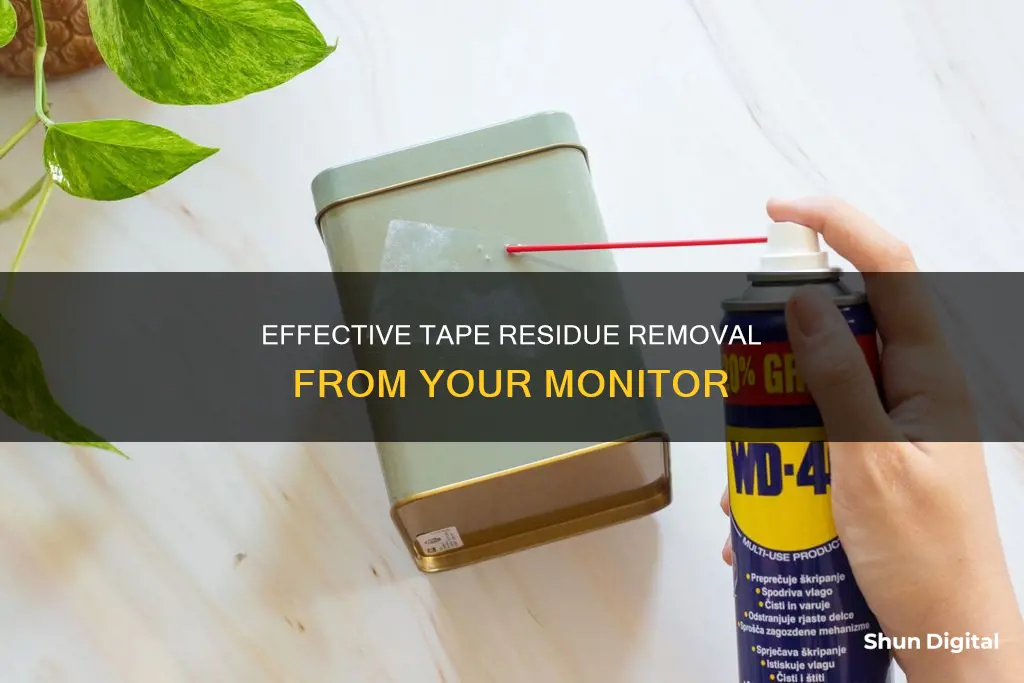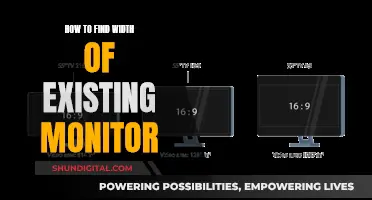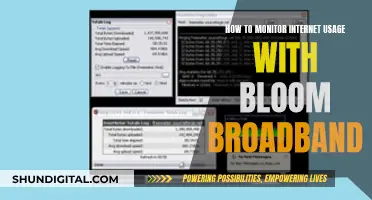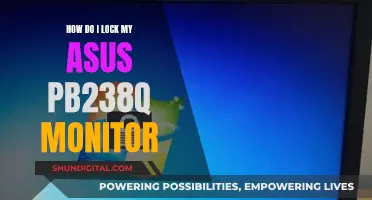
Removing tape residue from a monitor can be a tricky task, especially if you want to avoid damage. There are various methods that can be employed to tackle this issue. One common suggestion is to use a damp cloth with warm water, which has proven effective in removing residue without causing harm to the screen. For more stubborn residue, a diluted isopropyl alcohol solution can be used, although this should be tested on a small area first to ensure it does not damage the screen. Other methods include using sticker residue remover, such as Goo Gone, or a small amount of cooking oil on a microfiber cloth, followed by a mild soap solution to wash away the oil.
| Characteristics | Values |
|---|---|
| Cloth | Lint-free, Microfiber |
| Liquid | Distilled water, Warm water, Rubbing alcohol, Vinegar, Olive oil, Canola oil, Dawn soap, Citrus bike chain degreaser, Glass cleaner, Isopropyl alcohol |
| Other | Lighter and sandpaper, WD40, Goo Gone, Sticker residue remover, Plastic card, Cotton swab, Magic eraser |
What You'll Learn

Using a lint-free cloth
If you want to remove tape residue from your monitor, using a lint-free cloth is a great option. This method is recommended by TV manufacturers, such as TCL, to ensure you do not accidentally void your warranty.
Firstly, take your lint-free cloth and gently rub the affected area of the screen. You may find that the residue comes off without needing to dampen the cloth. If not, try dampening the cloth with warm water and gently rubbing the area again.
If the residue is being stubborn, you could try dampening the corner of the lint-free cloth with a few drops of sticker residue remover, such as Goo Gone, or a diluted isopropyl alcohol solution. Be sure to only dampen the cloth very slightly, you do not want to saturate it. Gently rub the residue with the cloth, applying a little pressure.
If you are still struggling to remove the residue, try using a plastic card to scrape off as much as you can. Then, put some glass cleaner on a cotton swab and wipe the area. Finish with another wipe using a lint-free cloth and glass cleaner to ensure you remove any remaining residue from the sticker remover.
Turning Off Splendid Demo on Your ASUS Monitor
You may want to see also

Warm water and gentle scrubbing
Start by dampening a microfiber cloth with warm water. You can also use distilled water if you have some available. Gently scrub the affected area of the screen with the damp cloth, applying a little bit of pressure. The warmth of the water will help to soften the adhesive, making it easier to remove. Continue scrubbing gently until the residue is gone.
If the tape residue is particularly stubborn, you can try using a lint-free cloth or a soft cloth, such as a microfiber cloth, dampened with a small amount of soap or detergent. Avoid using too much soap, as you will need to wash it off the screen with water afterwards. Gently scrub the area with the soapy cloth, and then rinse and dry the screen with a separate damp cloth.
In some cases, you may find that the tape residue comes off more easily with a dry cloth. Before resorting to water or other cleaning solutions, try using a dry microfiber cloth to gently scrub the affected area. You may be surprised at how much of the residue you can remove without the need for additional liquids or chemicals.
It is important to note that when using the warm water and gentle scrubbing method, you should avoid using too much pressure or force. This could damage the screen or leave scratches. Instead, be patient and persistent, gently working at the residue until it is completely removed.
Monitoring Power Usage: Breakers in Your Home
You may want to see also

Rubbing alcohol
Firstly, it is important to gather the right tools and materials. You will need a soft, clean microfiber cloth and some isopropyl rubbing alcohol. Microfiber cloths are ideal because they are gentle and effective at removing dirt and residue without causing scratches. Ensure that your cloth is free from any debris or particles that could potentially scratch your screen.
Next, you will need to prepare the cleaning solution. Pour a small amount of the isopropyl rubbing alcohol onto the microfiber cloth. You want the cloth to be damp, but not soaked. Be careful not to use too much, as excess liquid can drip and cause damage to your monitor.
Now, you are ready to start cleaning the tape residue. Gently rub the damp cloth in a back-and-forth motion over the affected area. Be gentle and avoid applying too much pressure, as you do not want to damage the screen. Continue this motion until you see the residue starting to lift and come off.
If the residue is particularly stubborn, you may need to repeat the process a few times. Always allow the area to dry between attempts and inspect the screen to ensure no damage has occurred. You can also try leaving the damp cloth on the affected area for a few minutes to let the alcohol soften the residue before gently rubbing it away.
Finally, once you have successfully removed the tape residue, use a dry corner of your microfiber cloth to gently buff the area and remove any remaining residue or streaks. Ensure that your monitor is completely dry before turning it on or using it.
It is important to note that while rubbing alcohol is generally safe for screens, it is always a good idea to test it on an inconspicuous area first. Additionally, avoid using ammonia-based cleaners on your monitor, as they can cause damage.
LCD Monitors: Does Brightness Fade Over Time?
You may want to see also

Sticker residue remover
Sticker residue can be a pain to remove, especially from delicate surfaces like a monitor screen. Here are some methods to safely remove sticker residue from your monitor without causing damage:
Using a Cloth and Water:
- Firstly, try using a lint-free or microfiber cloth. Gently wipe the screen with the dry cloth to see if the residue can be removed without any additional solutions.
- If the residue is stubborn, dampen the cloth with warm or distilled water and gently wipe the affected area. Avoid using too much pressure, and instead, wipe in a circular motion to lift the residue.
Adhesive Removers:
- If water doesn't work, you can try using a small amount of adhesive remover, such as Goo Gone, on a soft cloth or cotton swab. Gently rub the affected area, being careful not to go outside the glass parameters of the screen.
- Another option is to use diluted isopropyl alcohol (IPA). A solution of less than 50% IPA and water is generally safe for cleaning screens without causing damage.
- You can also try a 1:3 dilution of IPA to distilled water. Gently apply this solution to the residue and let the alcohol do the work, avoiding excessive pressure or scrubbing.
Alternative Methods:
- For a more natural approach, you can use a few drops of cooking oil, such as olive oil or canola oil, on a microfiber cloth. After removing the residue, wash the oil off with a mild and diluted soap solution.
- Another alternative is to use a small amount of citrus-based bike chain degreaser, which is safe, non-toxic, and effective at removing residue.
- You can also try using a new piece of tape to lift off the residue. Stick the tape to the residue and then lift it off, repeating this process until the residue is gone.
Always be cautious when trying any of these methods, especially those involving chemicals. Test a small, inconspicuous area of your monitor first to ensure that no damage occurs. Additionally, avoid spraying any solutions directly onto the screen. Instead, apply them to your cloth or swab of choice and then to the screen.
Blind Spot Monitors: Where Are They on WRX Models?
You may want to see also

Plastic card and glass cleaner
If you are looking to remove tape residue from your monitor using a plastic card and glass cleaner, here is a step-by-step guide:
Firstly, gather your supplies. You will need a plastic card, such as an old credit card, and a glass cleaner of your choice. It is important to choose a non-abrasive plastic card to avoid scratching the surface of your monitor. Some recommended glass cleaners include:
- Distilled white vinegar: Soak a cloth or paper towel in vinegar and lay it over the sticky area for at least 10 minutes. You can also heat the vinegar slightly in the microwave to make it more effective.
- Isopropyl (rubbing) alcohol: Place a few drops of isopropyl alcohol on a cotton ball or paper towel and saturate the sticker. Wait for at least 10 minutes, then use your plastic card to remove the adhesive.
- Commercial glue removers: Products like Goo Gone or De-Solv-It are designed to remove sticky residue. Apply them to the residue and let them sit for a few minutes before using your plastic card to scrape it off.
Now, you are ready to start the cleaning process:
- If there are any large pieces of tape remaining on the monitor, carefully peel them off. Try to remove as much of the tape as possible without leaving behind any small pieces that could create more residue.
- Apply a small amount of your chosen glass cleaner to a cloth or cotton ball. You only need a few drops or a light spray, depending on the product.
- Saturate the tape residue on the monitor with the glass cleaner. Make sure the area is completely covered and let it sit for at least 10 minutes. This will give the cleaner time to penetrate and loosen the adhesive.
- Gently scrape away the residue using your plastic card. Hold the card as flat as possible against the surface of the monitor to avoid scratching it. Work slowly and carefully, applying light pressure to lift off the residue.
- Repeat the process if necessary. If there is still some residue left, reapply the glass cleaner and use your plastic card to scrape it away.
- Finally, use a microfiber cloth to wipe down the monitor. This will remove any remaining residue and leave a streak-free finish.
Remember to work slowly and carefully throughout the process to avoid damaging your monitor. Additionally, always read the product labels and instructions before using any glass cleaner, and test it on a small, inconspicuous area first to ensure it does not damage the monitor's surface.
Resetting Your ASUS Monitor's Colors: A Step-by-Step Guide
You may want to see also
Frequently asked questions
Use a lint-free or microfiber cloth, damp with warm water. If the residue is stubborn, try a diluted solution of dish soap and warm water.
Yes, some people have found success using products such as Goo-Gone or diluted isopropyl alcohol.
Although WD-40 may be effective, it is not recommended for use on LCD screens.
Yes, but proceed with caution. Use a new plastic razor blade and ensure that both sides are firmly pressed against the screen to distribute pressure evenly.
Try using a small amount of cooking oil on a microfiber cloth, then wash it off with a mild and diluted soap solution.







